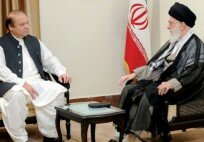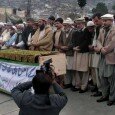By Yasir Habib Khan –
U.S.-Pakistan Professional Partnership Program for Journalists is trying to bridge gulfs between the people of two countries by removing misgivings but much more is needed to be done to reap maximum benefits from the massive spending
U.S.-Pakistan Professional Partnership Program for Journalists, despite all its innate utilities and meaningfulness, is underperforming as majority of 183 Pakistani journalists except few journalists who availed the program since 2010 could not make a difference in their respective professional domains.
The program, going to end in August 2017, is to bring 47 more journalists from Pakistan to the United States. The International Center for Journalists (ICFJ) in Washington D.C. manages the said program funded by the U.S. State Department’s Bureau of Educational and Cultural Affairs (ECA). Its main partner is the United States Educational Foundation in Pakistan (USEFP). The USEFP is responsible for the selection of Pakistani journalists and ICFJ runs all aspects of the program.
The 7-year long program costing 4.5 million US dollars is fulfilling just one part of its objective which is to train journalists in sensitizing audiences both in Pakistan and the U.S. a more balanced picture of life, culture and events in each other’s countries and stamping out existing myths, misperceptions and misgivings.
Other imperative part of the program aims to provide an opportunity to train selected journalists to equip them with hands-on learning in the U.S. media outlets. Journalists are supposed to apply this practical experience in their own media organizations to impact their respective field positively. It paves way to produce future leaders in journalism field. It is also designed to provide participants from Pakistan to use digital and multimedia tools that are changing journalistic work in both countries. Unfortunately, vital essence of this program which equally carries great magnitude stays half fulfilled so far.
Even the most recent 12th batch of the program, comprising 17 journalists hailing from different regions and media organizations, which spent one month in the U.S. and returned back foundered to justify set targets in totality. Apart from two or three, during their presentations held at ICFJ office in Washington DC on October 22 and October 24, other participants shared only how and what explored, observed and experienced visiting places and interacting Americans of diverse culture, society, values and mindset.
During the debriefing, U.S. state department officials including Karin L Brandenburg, Annie M. Simpkins accompanied by ICFJ deputy vice president Elisa Tinsley and program assistant Nolen Meyer asked the participants what were their professional gains and how they were going to milk them in Pakistan. Surprisingly, most of them ended up their reply with learning a lot and will try to capitalize it indeed.
They fell short of identifying or pinpoint their specific learning proficiencies or take away that may be impacting their working competence and career building to emerge as a catalyst to change. One or two participants brought into notice some drawbacks of the program which testifies clearly as to why program stood half utilized and stayed away achieving its all targets. During the course of placement with prescribed media outlets in the U.S., participants of the program just observed daily execution of journalist tasks. Except some, majority of them are not allowed to be part of journalistic operations by pitching their stories, editing the news, broadcasting and airing the news and producing some assignments. So much so participants are less exposed to digital media trends in the U.S.
On a query, ICFJ deputy vice president Elisa Tinsley clarified that ICJF could not facilitate every participant to get practical experience as mentioned above due to complexity of the Union laws in the U.S.
Defending the situation, ICFJ vice president Patrick Butler argued “ICFJ’s U.S.-Pakistan Professional Partnership in Journalism is an exchange program that gives journalists in Pakistan and the United States a chance to study each other’s culture as they are immersed in newsrooms in each country. The goal is for the participants to experience how U.S. and Pakistani newsrooms operate – the similarities and differences – and gain a more nuanced perspective on each other’s countries. Ultimately, the program aims to improve mutual understanding among professionals whose work can have a significant impact on people in both countries.”
He added that ICFJ had seen participants gain a far greater understanding of the diversity and richness of each other’s cultures. In reports to ICFJ about their experiences, he claimed that the journalists said the program dispelled misconceptions and in some cases biases they had developed as a result of a lack of exposure to the realities on the ground.
Officials of state department of the U.S. told Pique that program had been proving result-oriented. “Previous participants of the program like anchor Shoukat Ali Zardari of Awaz TV Karachi streamlined his newsroom after learning media management skills during his attachment at WRCB-TV in Chattanooga. Another participant Ali Raza shared that having gained digital and social media skills at the Tallahassee Democrat in Florida, he created the first website and Facebook page for the Daily Asr-e-Nau,” they illustrated.
Under the program, twenty-six American journalists have visited Pakistan so far. Another 44 will visit before the program ends. The program is funded by two consecutive grants from the U.S. Department of State. The grants cover the period from August 2010 to August 2017.
When asked about the utility of program, Stephen Magagnini, senior Journalist at Sacramento Bee, one of biggest newspapers in California said: “There is no tracking system to fathom what each badge (Pakistani and U.S. journalists) impacted and whether aims and objectives designed to get desired outcome have been produced.”
He explained, “We do not have specific statistics to claim that this program have made a difference. I went on the same program but all the other journalists visited Pakistan and returned to the U.S. never met again and shared their experiences with one another. To me it was just a program through which both side journalists visited each other, filed few stories and later out of sight out of mind.”
Associate professor of California State University-Sacramento Molly Dugan was of the opinion that interaction had brought people closer to each other, helped improve understanding, paved way to minimize misgivings and finally provided the foundation for building a mutual, friendly and respectful world shunning all prejudices. “I believe that U.S.-Pak Professional Partnership Program for Journalists is a robust opportunity to look into each other political system, cultural values and social shades through one’s own lenses and pragmatism. Journalists develop opinions and help people to cultivate a mind to influence issues. We do not think that tax-payers money used by state department of the U.S. for the program is being drained out. We are sure that program is on right path and sooner or later will dilute suspicions, fear and mistrust and foster harmony – key formula to establish peace in the world,” she added.
In reply to a query that most of the people believed that Pakistanis journalists are being brought in the U.S. to brainwash them so that they could be a mouthpiece of U.S. and serve their purposes, ICFJ officials said that program aimed to introduce journalists from Pakistan and their American colleagues to the media and life in each other’s countries. “The participants get a chance to see how things are for themselves. For the Pakistani journalists, this means traveling on their own to a selected city and media outlet, where they spend three weeks seeing how a newsroom operates and living in local communities. They are free to come to their own conclusions about how American media work and how people live in the U.S. The program makes no attempt to influence participants’ opinions about U.S. foreign policy,” they elaborated.
U.S. state department program officer of Europe/South and Central Asian Division Karin L Brandenburg said that one the reasons behind World War II was the communication gap between countries. U.S.-Pakistan Professional Partnership Program for Journalists would help build the bridges and dispel the misconceptions among the people living in different part of the world, he added.
In a nutshell, program has great significance and leaves its lasting imprints on both Pakistan and U.S. journalists. However, if practical assignments are made mandatory part for every participant of the program negotiating all adversities and complexities with putting more emphasis on tracking down impacts of learning received through the program, benefits may be reaped at maximum level.
![]() The writer is a Lahore-based journalist who recently availed U.S.-Pakistan Professional Partnership Program for Journalists and worked as an internee with Sacramento Bee California
The writer is a Lahore-based journalist who recently availed U.S.-Pakistan Professional Partnership Program for Journalists and worked as an internee with Sacramento Bee California































































































